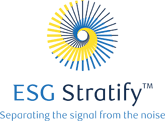Key Points:
- Widely used ESG reporting frameworks such as the Global Reporting Initiative (GRI) and the Sustainability Accounting Standards Board (SASB) influence how hyperscalers and datacenter operators set targets and disclose the environmental impacts of their businesses.
- Datacenters and hyperscalers can assess progress on ESG targets by focusing on renewables, carbon intensity, and both water and data center power efficiency. Since disclosure practices differ by operator, and variances in these metrics are driven by geography, age of portfolio, and other factors, RBC encourages operators that do not provide full disclosure to provide updates to stakeholders based on indexed values (e.g., a 2022 baseline) so that stakeholders can gauge the progress that datacenter operators and hyperscalers are making toward their environmental goals.
- The vast and complex ratings agency landscape suggests that there may be little correlation between ratings agencies and environmental sustainability practices.
- Nearly $280 billion of the roughly $1.3 trillion AUM in sustainable equity funds is specifically focused on environmental themes such as climate, water, and biodiversity.
The prevalence of environmental stewardship has heightened the focus on reporting and disclosure practices among datacenters and hyperscalers, also known as cloud infrastructure stakeholders.
Many organizations have attempted to standardize ESG disclosures, but the ESG ecosystem has become vast and complex, consisting of a wide range of research and ratings providers, sustainability reporting standards providers, market data vendors, and credit rating agencies.
Although there is some uniformity among reporting frameworks, many stakeholders have told us the ratings landscape appears chaotic, with limited analytical insight. We believe metrics quantification and industry comparability may improve over time, especially as issuers, investors, and agencies increase adoption of ESG frameworks and communications efforts.
In this report, we break down how datacenters and hyperscalers currently oversee environmental metrics and reporting practices.
SASB and GRI frameworks influence reporting and disclosure
Widely used ESG reporting frameworks such as the Global Reporting Initiative (GRI) and the Sustainability Accounting Standards Board (SASB) have the most influence on how hyperscalers and datacenter operators set and disclose ESG targets.
Most companies also rely on the Greenhouse Gas Protocol (GHGP), the Task Force on Climate-related Financial Disclosures (TCFD), and the Science-Based Targets Initiative (SBTi). Other organizations such as the Carbon Disclosure (CDP), and the Global ESG Benchmark for Real Assets (GRESB) use detailed surveys to measure ESG performance.
Despite this range of reporting frameworks, there is some uniformity on factors that matter most for datacenters, such as greenhouse gas emissions, renewable energy, and water sustainability. Energy-efficiency improvements, as well as the switch to renewable and low-carbon electricity, will help improve carbon intensity.
Stronger focus on carbon and renewables can gauge progress toward targets
Hyperscalers and datacenter operators are striving to enhance energy and cooling efficiency, source renewable energy, reduce their carbon footprint, and enhance water sustainability. Each company faces unique circumstances dictated by geography, scale, and business model that make comparisons across operators challenging.
We believe a consistent focus on these four key metrics can help gauge progress toward meeting environmental targets:
- Carbon intensity: The common metric used to gauge greenhouse gas emissions characteristics, after factoring in business scale (as measured by energy use, or revenues) and the average emission rate for the specific mix of primary energy used to generate electricity provided to the electric grid.
- Renewables mix: The way data centers draw energy from renewable sources such as solar, natural gas, wind, nuclear, and geothermal.
- Datacenter power usage effectiveness (PUE): The ratio of the total amount of power used by a computer data center facility to the power delivered to the IT equipment. PUE is equal to 1 or greater, and the closer PUE is to 1, the more efficient the datacenter.
- Water use efficiency (WUE): Projects include the reduction of potable water use for cooling; on-site water treatment; rainwater capture, and water restoration, particularly in vulnerable regions with high water stress.
Companies and investors have low confidence in rating agency tools
The landscape of ratings firms and third-party aggregators that evaluate environmental practices is complex. Many companies and investors place limited confidence in these tools and as a result, there may be little correlation between ratings and actual environmental sustainability practices.
Additionally, for hyperscalers, the correlation of “E”-related sustainability efforts with aggregate ESG ratings is low given their business models, industry classifications, and weightings of other ESG factors. For datacenter pure plays, for instance, “E”-factors comprise a greater portion of ESG ratings.
Green bond financings headline investment themes
We estimate there is roughly $1.3 trillion AUM in dedicated sustainable equity fund products globally, of which $280 billion is focused explicitly on environmental themes.
Green bond financings and corporate investments remain the most common themes in the sector, with six issuances totaling ~$4.7B in 2021 and 2022 and ~3,620MW worth of PPA investment in 2021 and 2022.
Among ESG engagements, climate is still the primary focus of investors, followed by water and biodiversity.
Our Commitment to ESG
RBC Capital Markets’ ESG StratifyTM encompasses all our ESG thought leadership and insights, including our monthly ESG Scoop series and industry-specific publications from our research analysts. RBC’s Equity Research Group delivers thorough, comprehensive assessments of companies spanning all major sectors, along with macro insights and stock-specific ideas to help guide portfolio management decisions.

RBC’s Equity Research Team authored “RBC ESG Stratify: Datacenters and Hyperscalers--An Environmental Overview” published on January 25, 2023. For more information about the full report, please contact your RBC representative.

